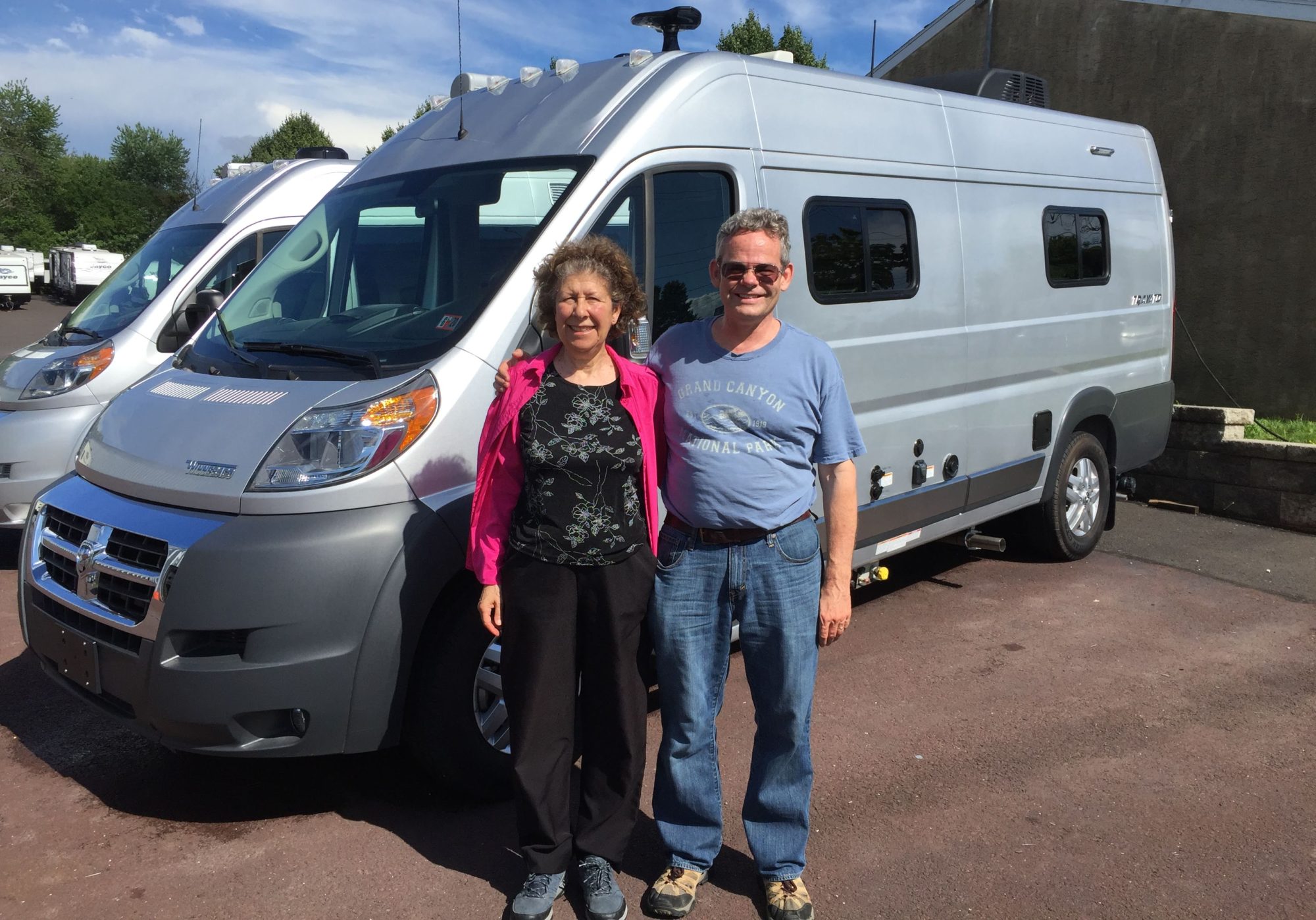Shenandoah Valley (Dec. 11 -14)
We decided to spend our first day in Shenandoah at the Luray Caverns. What a great choice!
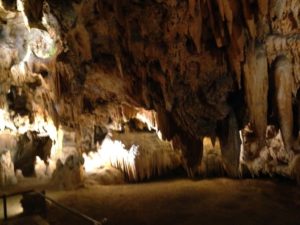
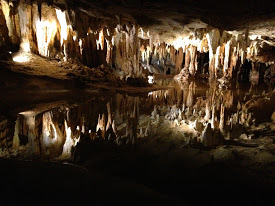
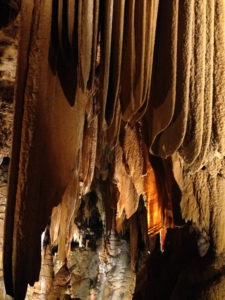
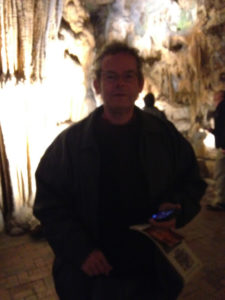
The Luray Caverns are the most spectacular caverns that Chuck and I have seen together (including other trips). The minute you enter the cave, you are surrounded by amazing rock formations: stalactites and stalagmites, pillars, draperies, grape-like formations, cave “bacon” and more. A guide takes you on a 1 mile hike through this wonderland, which includes a mesmerizing reflective pool (above, left) and formations of all sizes.
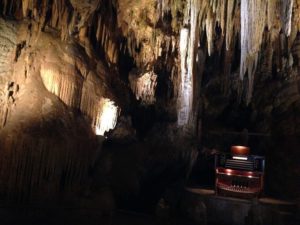 A unique feature of the cavern in the Stalagpipe Organ. This is an xylophone, whose keys are stalactites. It is controlled by this “organ”, but the keys activate the little hammers as can be seen in the center of the picture below.
A unique feature of the cavern in the Stalagpipe Organ. This is an xylophone, whose keys are stalactites. It is controlled by this “organ”, but the keys activate the little hammers as can be seen in the center of the picture below. 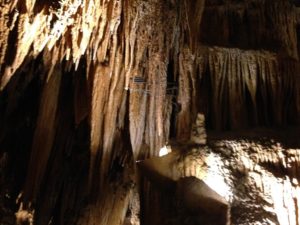 It is an amazing instrument, but I do worry that the constant vibration of the formation will lead to crystal fatigue and ultimately damage to the cave.
It is an amazing instrument, but I do worry that the constant vibration of the formation will lead to crystal fatigue and ultimately damage to the cave.
Luray is only a 4 hour drive from State College, and I highly recommend this to my SC friends. However, you do have to be able to manage several flights of stairs to see this cavern.
As well, the attraction has 3 museums, all very good.
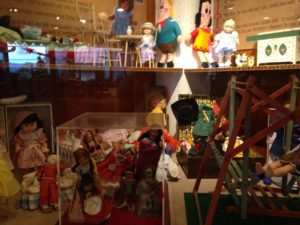 The toy museum has displays of toys from America’s past, with some discussion of how the toy evolved. e.g. doll heads used to be made of bisque (a type of ceramic) so their hair used to be either painted on or wigs. Once plastic heads were developed, synthetic hair could be “rooted” in the scalp.
The toy museum has displays of toys from America’s past, with some discussion of how the toy evolved. e.g. doll heads used to be made of bisque (a type of ceramic) so their hair used to be either painted on or wigs. Once plastic heads were developed, synthetic hair could be “rooted” in the scalp. 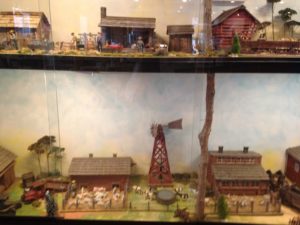 On the other hand “talking” dolls were available in 1890. The centerpiece of the display was a large model train set, which was well-done but less interesting to me. However, there was also a model train set (right) that had been entirely hand-crafted by a pediatrician out of balsa wood which I found very interesting.
On the other hand “talking” dolls were available in 1890. The centerpiece of the display was a large model train set, which was well-done but less interesting to me. However, there was also a model train set (right) that had been entirely hand-crafted by a pediatrician out of balsa wood which I found very interesting.
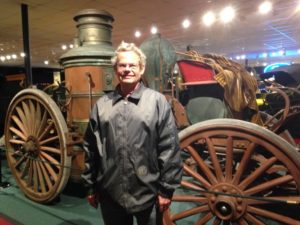
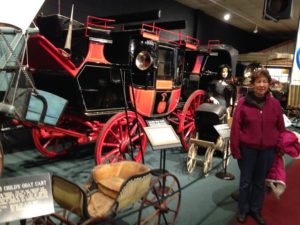 The car museum had the best collection of antique vehicles we have yet seen, including a horse drawn fire truck with a steam-powered water pump (left) and many unique carriages, coaches, sledges, carts and buggies. The stage cage below could hold 20 passengers + luggage (although most of the passengers sat on the outside at roof level. This photo also shows a child’s cart which was pulled by two goats (the small white vehicle) and a woman pushing a vintage baby carriage. The museum also had a fine collection of very old luxury cars, many with wooden chassis and leather and brass trim and car motors. Finally, it had a lot of interesting miscellanea.
The car museum had the best collection of antique vehicles we have yet seen, including a horse drawn fire truck with a steam-powered water pump (left) and many unique carriages, coaches, sledges, carts and buggies. The stage cage below could hold 20 passengers + luggage (although most of the passengers sat on the outside at roof level. This photo also shows a child’s cart which was pulled by two goats (the small white vehicle) and a woman pushing a vintage baby carriage. The museum also had a fine collection of very old luxury cars, many with wooden chassis and leather and brass trim and car motors. Finally, it had a lot of interesting miscellanea.
The last museum is the Luray Valley Museum, which is a historical museum. It has some unique exhibits. Apparently the Shenandoah Valley, besides being a big agricultural area, was a big iron-producing area, producing cast-iron stoves. Since these were shipped around the country, first by Connestoga wagon and then by train, the stoves needed to be shipped in pieces and then assembled upon delivery – the IKEA of its time. The museum had a large display of stove panels from various models, and with discussion about the decorative as well as functional features.
Many of the settlers in the valley were German Anabaptists. One interesting artifact is an anabaptist bible dating from 1536. In Europe, this bible was considered heretical, and being caught carrying this book could lead to very serious consequences (including death).
Another interesting note in the museum concerned Stonewall Jackson, a famous Confederate general who led the Confederate forces in the Shenandoah Valley. Before the war, Jackson and his wife both taught school to slave children (which was illegal at the time) along with another woman who was a staunch abolitionist. (The display was actually about her life.) During the war, she was imprisoned by the Confederates for supporting the Union, but Jackson effected her release. The local high school is named after him and it will be interesting to see how it fares in the current controversy about honoring Confederate heroes.
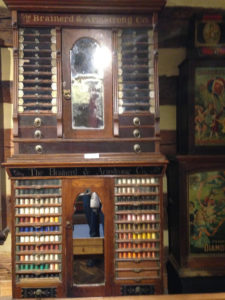 The museum also had a small display of very old toys and of quilts. I liked this cabinet for embroidery and quilting thread that was used for store display.
The museum also had a small display of very old toys and of quilts. I liked this cabinet for embroidery and quilting thread that was used for store display.
As well, the museum has a number of restored historic buildings including a house, schoolhouse and smithy.
To get to Luray, we had to cross the mountains through a low pass through the Massanutten Mountains. We did not want to cross this after dark, which is about 5 p.m. so we headed back early and went into the small town of New Market. We ended up having an early dinner at Kathy’s Cafe – a small and friendly restaurant downtown.
By the time we got back to the RV, it was windy, snowy and very cold. Nonetheless, Rumple seemed to want multiple walks. One advantage of home – a backyard where he can go out without supervision (although on a rope).
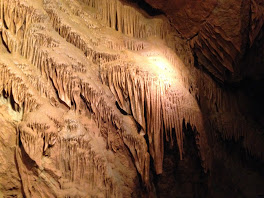
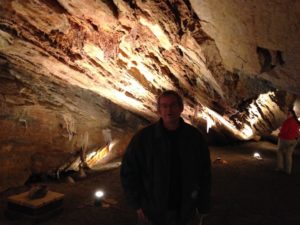
For our second day in Shenandoah, we visited the Shenandoah Caverns, which also have a number of side attractions. The caverns are less ornamented than the Luray Caverns, but are interesting in other ways. The caverns are full of natural passageways, and the rocks themselves are very interesting. Often you are walking beneath huge slabs of rock so smooth they look like they have been finished by a rock smith. In other places, there are huge shattered boulders balancing on the cave floor or between the walls. One large cavern was at the junction of two underground rivers, and the cavern walls have been scoured in great eddies.
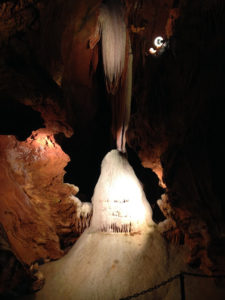
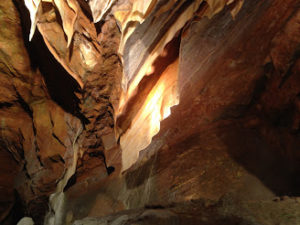
The cavern has fewer big pillars than Luray, but lots of cave draperies and cave bacon (above). Some of the formations have an outer crust of crystalline calcite, which makes them glitter like something out of a fairytale.
The old entrance to the cave was by steps, but this has been replaced by an elevator. Because of this, the hike is less strenuous than Luray. However, several of the natural rock passageways, although wide, are less than 5′ high, so some ducking is required.
After the tour, we had lunch at the adjacent cafe, which is a 1950’s lunch counter. It looked just like the lunch counter that my stepgrandmother used to run in a small town in Ontario, except that the linoleum counter and the stools were green instead of red. We were the only customers, so the manager stopped to talk with us.
Patty has worked at the caverns for 30 years, through several owners. She was originally hired as a tour guide when her first child was only 2. Her husband thought she was going a bit stir-crazy in the house, and when her cousin, at the time the only guide, told her that they were hiring a second guide, she went in for the interview. She continued to guide through 2 pregnancies. She also works in the gift shop and manages the cafe. This is the first year the cafe has been open after Labor Day – it was quite busy up until Thanksgiving, but was very quiet when we were there. However, the cafe also served lunch up to the staff, so perhaps it will survive the winter slow-down.
Patty told us about the ownership and management of the caverns since the 1950s, as well as some of the history of the main building. The most interesting thing is that not only the ownership, but also the management, has stayed within families (one for the owner, another for the management).
The former owner, E. Hargrove, was part of a family business which did large-scale decorations such as Inaugural Day Parade floats, and department store Christmas windows. There is a large museum called American Celebrations on Parade, which houses many of the historic floats. Unfortunately, because of the heating bill, it is not open in the winter.
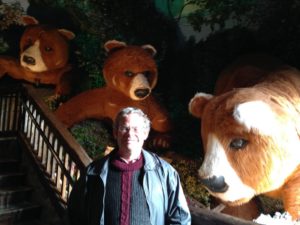 The main building houses a display of department store animated figures. When I was a child, the big department stores in Toronto were Eatons and Simpsons.
The main building houses a display of department store animated figures. When I was a child, the big department stores in Toronto were Eatons and Simpsons. 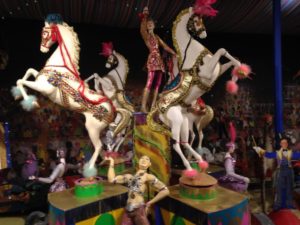 They were on opposite corners of two of the downtown streets, Yonge and Queen. Every Christmas, after the Santa Claus parade, they would convert their street-side display windows to large animated displays of fairy-tales, nursery rhymes or children’s songs.
They were on opposite corners of two of the downtown streets, Yonge and Queen. Every Christmas, after the Santa Claus parade, they would convert their street-side display windows to large animated displays of fairy-tales, nursery rhymes or children’s songs. 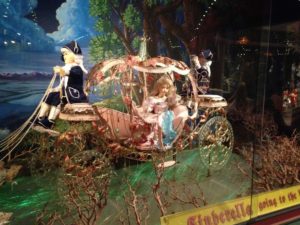 We always made a special trip downtown to see these displays. The “Main Street of Yesteryear” exhibit was a small selection of these animations, including Cinderella, a huge 3-ring circus that was once a Macy’s display, a castle, and more. As for the displays in Toronto – Simpsons and Eatons are no more, and the street-level shops have been replaced by the Eaton Centre, which is mostly underground (and much warmer at Christmas).
We always made a special trip downtown to see these displays. The “Main Street of Yesteryear” exhibit was a small selection of these animations, including Cinderella, a huge 3-ring circus that was once a Macy’s display, a castle, and more. As for the displays in Toronto – Simpsons and Eatons are no more, and the street-level shops have been replaced by the Eaton Centre, which is mostly underground (and much warmer at Christmas).
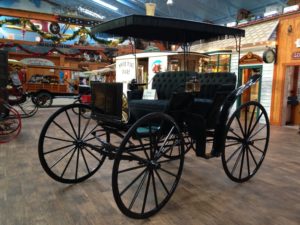
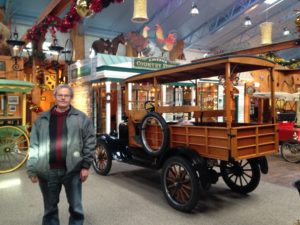
The final exhibit on the grounds is the Yellow Barn, which houses many old buggies, cars, carts and sledges, as well as other antiques such as an old barbershop.
Entrance to the 3 above ground exhibits is free, so perhaps we will stop back another time to see the American Celebration museum
Just down the street from the caverns, and from our campground, is the Route II Potato Chip Factory. Here you can watch most of the process of making potato chips from washing the potatoes, to slicing, to frying, inspecting, the fried chips, seasoning, bagging, and even boxing the bags (although photos are not allowed). Much of the process is automated (e.g. there is a device that can slice 100 lb of washed and peeled potatoes into chips in less than a minute) but the boxing is done by hand. I am assuming that this is due to the fragility of the product. Interesting factoid: 100 pounds of raw potatoes converts into 25 lbs of chips – the rest goes up in steam as the chips fry. Peelings and chips that do not pass inspection (before seasoning) are sold to a local farmer as cattle feed.
A fun part of the visit is that you can sample the product. They had about 10 flavors out for tasting. The chips were really good, but this is the wrong stage of our trip to be stocking up, so we did not become customers. Based on the numbers of boxes stacked up in the loading bay, and the number of tractor trailers heading in and out, our business will not be missed.
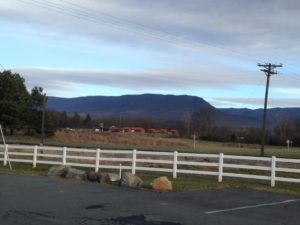 The views from both Shenandoah and Luray Valleys is lovely. This is the ridge and valley system, and the mountain ridges go on for miles. Here is the view looking towards the campground.
The views from both Shenandoah and Luray Valleys is lovely. This is the ridge and valley system, and the mountain ridges go on for miles. Here is the view looking towards the campground.
This is the last day of our trip. Tomorrow we will be home.
